SALEM, N.H., March 7, 2008 -- With StockerYale's leading role in doped fiber production for fiber lasers, increasingly important role in providing specialized illumination for machine vision, and ever-increasing sales in medical instrumentation markets, the future looks bright.
Specialized illumination for the ever-evolving 3-D and 2-D machine vision market: this has emerged as a central theme in StockerYale's products and research and development activities. With its corporate headquarters in Salem and divisions in Canada, Ireland and the UK, the company employs roughly 230 people worldwide.
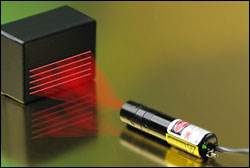
StockerYale's Lasiris line generators incorporate a patented optical lens system that eliminates the Gaussian distribution of the light, resulting in the most uniform laser lines in 3-D machine vision.
Founded in 1946, StockerYale relishes its unique status as the only photonics company to possess design and manufacturing know-how in three complementary illumination technologies (structured-light diode lasers for 3-D machine vision, and LEDs and fluorescent systems for 2-D applications).
In 2000, StockerYale founded its Specialty Optical Fiber research and fabrication facility. The fiber operation, located at corporate headquarters in Salem, designs and produces silica-based optical fiber for fiber-optic gyroscopes, erbium-doped fiber amplifiers, medical devices, and various sensors and components in defense, aerospace and telecommunications.
Importantly, StockerYale is one of the few companies in the world able to manufacture thulium, neodymium and ytterbium-doped fibers, for use in fiber lasers. The fiber laser is a truly revolutionary device, in which the laser output is generated within the specially doped core of an optical fiber. StockerYale is poised to become a leading supplier of these fibers, and anticipates important growth as fiber lasers continue to break records in power (kilowatts), reliability and low cost of ownership.
With StockerYale well-established in its existing markets, the company will be placing an increased emphasis on medical market business development in 2008. Mark W. Blodgett, chairman and CEO of StockerYale, said, "Our key objective in 2008 is to substantially expand sales to the medical instrumentation markets across all of our product lines. Sales to the medical vertical increased from less than 5 percent of StockerYale's total revenues in 2006 to approximately 12 percent in 2007, and we expect that they will represent approximately 20 percent of 2008 revenues given our existing customer relationships and multiple sales initiatives underway." (See also Stocker to Stress Med Tech)
Structured-Light Lasers
Structured light is laser light that is projected in precise geometric patterns (lines, grids, matrices of dots) for 3-D machine vision.
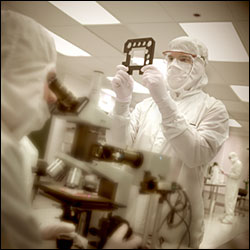
StockerYale manufactures diffraction gratings in its Class 100 cleanroom in Montreal.
The structured-light-generating technologies developed by StockerYale involve the use of diffractive and refractive optics. These precision optical elements are designed and manufactured in-house by StockerYale Canada, often in the company's Class 100 cleanroom. The company offers structured light generators which must perform to the demanding requirements of 3-D machine vision -- e.g. line generators that produce lines having a constant thickness of only 10 µm over a length of 60 mm.
The company's Lasiris PureBeam fiber-coupled lasers and patent pending Flat-Top² Generator laser beam shaping modules are enabling it to break into new markets such as flow cytometry, fluorescence, confocal microscopy, and DNA sequencing, which, like machine vision, require laser sources with extremely high output power stability and pointing stability.
Acquisition of Photonics Products Ltd. Broadens Laser Module Portfolio
In 2006, StockerYale broadened its offering of laser modules by acquiring the UK-based company Photonic Products Ltd. (See also StockerYale Acquires Photonic Products for $9.4M) The subsidiary manufactures custom diode-laser-based optoelectronic components and subassemblies for a variety of industrial and biomedical OEMs. Photonic Products is also a leading European distributor of laser diodes from Sanyo, Sony and Opnext, and distributes precision optical lenses from Panasonic. Photonics Products has twice won the Queen's Award for Enterprise.
LED Illuminators: Designed 'From the Chip Up'
While the structured-light product line serves 3-D machine imaging applications, StockerYale enables the world of 2-D machine vision with its high-brightness LED illuminators. The LED products are designed and manufactured by StockerYale Ireland, located in Cork. The strengths of this division include a number of proprietary LED packaging methods, as well as optical modeling and simulation know-how.
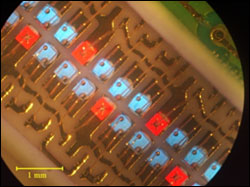
Multiwavelength arrays for 2-D machine vision and biomedical applications are designed and manufactured at StockerYale Ireland.
"When designing LED-based illumination solutions for OEM clients, StockerYale does not limit itself to any one assembly method. We like to draw from our broad understanding of LED technologies, incorporating various types of LED packaging techniques to construct the most cost-effective solution for a given application," said Simon Stanley, manager of the LED business unit.
StockerYale Ireland stands as an example of how LEDs, widely touted as "the light bulb of the future," are indeed beginning to prevail in 2-D machine vision illumination. A case in point: The company has launched the Cobra (chip-on-board reflective array) line-scan illuminator product line, intended for high-speed line scan and web inspection -- the 100 percent inspection of continuous (or endless) items such as paper, plastic film, foil, etc.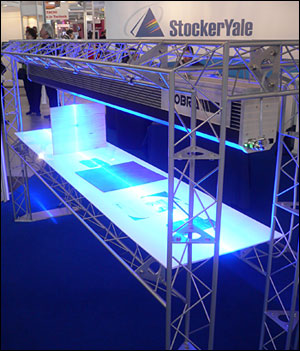
StockerYale's newest generation of Cobra line illuminators made a splash at Vision 2007 in Stuttgart, Germany.
In such systems -- where the higher the speed, the greater the requirement for brightness -- fluorescent and halogen lighting have traditionally prevailed. But due to the availability of improved LED chips, and to the proprietary optical and packaging techniques employed by StockerYale, the Cobra illuminators can compete with, and surpass, previous lighting technologies in terms of performance and lower cost of ownership.
In the case of the Cobra illuminators, the intense optical output is achieved by means of the patented chip-on-board reflective array technology, an innovation in thermal and optical efficiency for LED arrays. The chip-on-board approach to LED module fabrication yields an essentially unbroken line of semiconductor light source, resulting in a high level of uniformity.
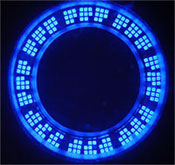
StockerYale manufactures miniature circular LED illuminators that can be integrated into handheld dental tools.
StockerYale has recently launched a new generation of Cobra, involving line illumination up to 3 meters long, for web inspection. The high-power kilowatt Cobra line light technology is particularly effective in flat panel display inspection.
Like the structured-light lasers, the company's LED products are finding more and more applications in dentistry and medicine. For example, StockerYale LED modules will be serving as photoinitiators in clinical trials of pharmaceutical products in the spring of 2008. The company also expects to significantly ramp up production of its custom-engineered LED modules for handheld dental tools.
Specialty Optical Fiber
The Specialty Optical Fiber business is a rapidly growing part of the StockerYale family. The growth of the fiber business can be attributed, in part, to the increasing utilization of optical fiber to deliver laser light in medical and biomedical applications, and to the unprecedented rise of the fiber laser.
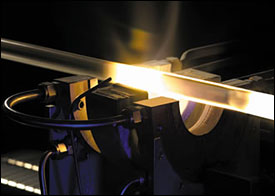
StockerYale's optical fiber preforms are made at corporate headquarters in Salem, N.H., using the modified chemical vapor deposition technique. The company is of one of a few firms in the world to able to manufacture thulium, neodymium and ytterbium-doped fiber for fiber lasers.
Among the standard products provided by the company are polarization-maintaining fiber for fiber-optic gyroscopes, and erbium-doped fiber, which is used in the fiber amplifiers deployed worldwide in optical telecommunication systems. Other off-the-shelf products include elevated numerical aperture fiber intended for use in fiber-optic devices where fiber is placed in tight bends, and single-mode fiber for the delivery of visible and ultraviolet (UV) light. Since UV light causes silica to solarize (that is, to darken or age), StockerYale has developed proprietary methods for the fabrication of solarization-resistant fiber.
StockerYale is one of a small handful of companies in the world that manufacture thulium, neodymium and ytterbium-doped fibers for use in fiber lasers. The company possesses unique techniques for the fabrication of these rare-earth fibers, and is poised to become a leading supplier.
An Innovative and Diversified Photonics Company
The on-going success of StockerYale has frequently hinged upon its ability to apply freshly developed cutting-edge semiconductor technologies to contribute to advances in the realm of machine vision. The incorporation of diode lasers in structured light generators, and the implementation of new high-brightness LEDs where other types of sources have been traditionally used, are cases in point. As to the specialty optical fiber business unit, with the increasing implementation of fiber-delivered lasers in medical and biomedical devices, as well as the unprecedented rise of the fiber laser, the future promises to be bright.
For more information, visit: www.stockeryale.com; e-mail: [email protected]
StockerYale Inc.
32 Hampshire Rd.
Salem, NH 03079
Phone: (603) 893-8778
Fax: (603) 893-5604